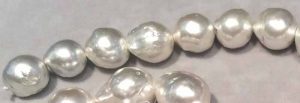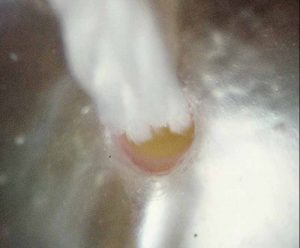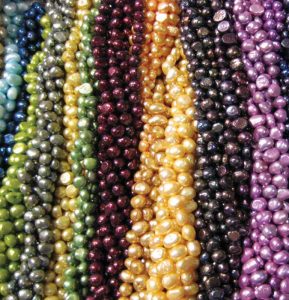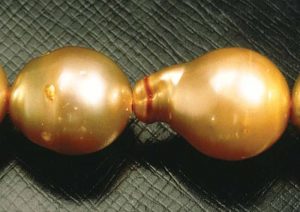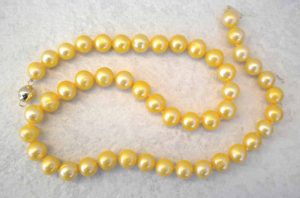Detecting pearl imitations and treatments
by carly_midgley | June 22, 2018 9:12 am
By Renée Newman
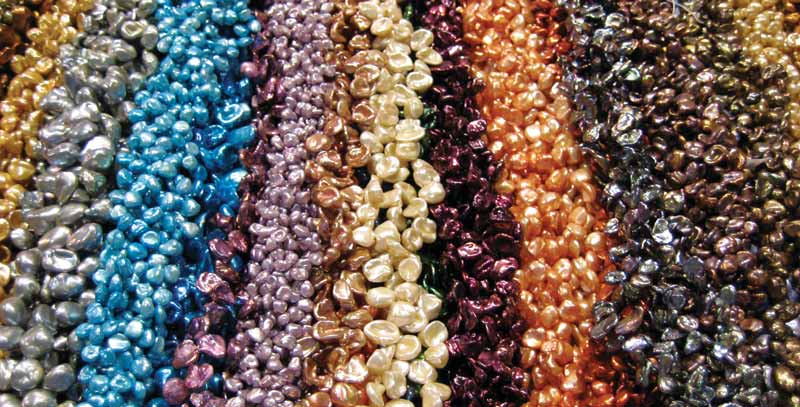 [1]
[1]Whenever something is prized, it is usually imitated, and pearls are no exception. Fortunately, fake pearls are easier to spot than many other gem imitations.
Putting pearls to the test
The following are some key tests for detecting imitation pearls.
Magnification
Under 10x magnification, imitation pearls have a grainy, glittery, speckled surface (Figure 1 on the next page). At higher magnification, this may look pitted and resemble the moon’s terrain.
Cultured and natural pearls display a smoother-looking surface under 10x magnification. Curiously, at very high magnification (about 50x and above), pearl nacre has maze-like, scaly patterns similar to the ones in Figure 2, which imitations lack. A fibre-optic light is helpful for viewing these patterns, while diffused fluorescent light makes them more difficult to see.
Magnification is the most reliable method for detecting pearl imitations. Nevertheless, it is wise to use a combination of tests to determine a gem’s identity.
Tooth test
If you rub the pearls lightly along the biting edge of your upper front teeth and they feel gritty or sandy, it is likely they are cultured or natural. This is the result of the microscopic ridges found on their surface (Figure 2). If they feel smooth, they are most likely imitations; however, occasionally real pearls are polished and may feel smooth. Additionally, a substance may be added to imitations’ coatings to make them feel gritty. Therefore, the tooth test does not always work. Magnification is a more reliable and sanitary way to detect fakes.
Blemish test
Genuine pearls often have blemishes that help distinguish them from imitations. Pits and welts like the ones in Figure 3 are very common. Jewellers should examine pearl blemishes with a 10x loupe whenever possible to learn what they look like.
Drill hole test
Drill holes also help differentiate real pearls from imitations. Cultured pearls often have a clear dividing line between the nacre and nucleus. The edges of their drill holes are usually sharp and well defined. Imitations, on the other hand, generally have a very thin coating, which may have ragged edges. Sometimes they have rounded ridges around their drill holes (Figure 4).
Heft
If you bounce a strand of pearls in your hand and it feels unusually lightweight, that’s a sign it may be made of plastic. However, it’s important to keep in mind imitations made of coated shell beads or glass may have the same heft as pearls, and some hollow cultured pearls may feel lightweight.
Perfect matching test
Coated shell beads are popular imitations because they have the same type of bead nucleus as cultured pearls, meaning they feel similar. Figure 5 shows two strands of coated shell beads. The black strand was sold as a Tahitian black South Sea shell pearl necklace and the white strand was sold as a white, AAA South Sea shell pearl necklace. Notice how the beads are perfectly matched for shape, size, and body colour. This is a good clue they are imitations. When their surface is examined with a 10x loupe, it appears grainy, which indicates they are not real pearls.
Overtone test
Good-quality real pearls have overtones that overlie the body colour. These normally vary in colour within a strand, as shown in the top two strands in Figure 6, which have pink and greenish overtones. The beads in the bottom strand do not show such variation because they are imitations. The shell beads in Figure 5 similarly lack overtones.
Talking treatments
Identifying fake pearls is usually relatively easy. What can be difficult, however, is to detect treatments. Knowing what signs to look for can make this process easier.
Coating
One treatment that seems to be appearing with greater frequency is the coating of pearls. This is done to improve lustre, change colour, and/or make low-grade pearls look as if they are of high quality. Figure 7 shows part of a coated pearl strand that was sold at a gem show without treatment disclosure. The coating was easy to detect with magnification—it had the same glittery and grainy appearance as the surface of imitation pearls, but the blemishes and drill holes indicated these were cultured.
Some cultured freshwater pearls have a natural metallic lustre and gold or bronze colours when they are harvested. However, sometimes those colours and lustre are the result of a thin metallic coating or lacquer. This is so thin it can wear off before the freshwater pearls are even worn. The bald spots visible in Figure 8 are not light reflections, but areas where the coating has peeled off.
Pinking
Akoya strands with a uniform pink body colour have usually been soaked in a pink dye. This is seldom disclosed, but can be determined by examining the pearls and their drill holes with a 10x loupe. Pink dye may be visible in the hole and in any cracks or pits (Figure 9).
Dyed cultured freshwater pearls
You don’t need a loupe to determine the cultured pearls in Figure 10 are dyed—their unnatural colours make it obvious. The best way to disclose these is to simply call them dyed cultured pearls. There is no need to use flowery terms such as ‘colour enhanced.’ These types of pearls typically have dye concentrations near the drill hole and in some pits and other blemishes.
Dyed golden South Sea cultured pearls
Beware of dyed golden South Sea cultured pearls. The dyed pearls seen in Figure 11 are easy to detect because of their concentrations of dye, but in most cases it is difficult to identify colour-treated pearls of this type, even with a microscope. High-tech equipment is required to confirm such pearls are of natural colour, so lab documents are advisable, especially if you don’t know the producer.
Many Internet vendors and some show vendors do not disclose their dyed golden pearls. For example, the strand shown in Figure 12 was advertised online as an Australian South Sea gold pearl necklace. Normally, when sellers identify their pearls as South Sea varieties, that means they are saltwater pearls from white-, gold-, or black-lip oysters. These, however, are dyed freshwater pearls. It is best to ask vendors if their pearls are saltwater or freshwater, then ask them to write the pearl type on the invoice and indicate if it is of natural colour or not. (Saltwater cultured pearls cost much more than freshwater cultured pearls.)
Dyed and/or irradiated grey pearls
If a black or dark grey cultured pearl is smaller than 8 mm (0.3 in.) in size, one should assume it is a dyed akoya or freshwater cultured pearl. It would be unprofitable to culture Tahitian pearls smaller than this, because larger bead nuclei can be used in black-lip oysters.
Many colour-treated freshwater pearls are sold as Tahitian pearls. Their shape—together with their dye concentrations and low price—are good clues they are not of natural colour. Even though there are many drop-shaped and irregular-shaped Tahitian pearls, they usually look different from freshwater pearl shapes. Irradiation can give them a bluish or greenish grey colour, and dye can make them darker.
Two common methods of darkening off-colour pearls are to soak them in a dye or in a silver nitrate solution followed by light exposure. The depth of the black to grey colour depends on the strength of the solution and the length of time they are soaked.
JVC treatment disclosure guidelines
It is the jeweller’s responsibility to know if pearls are treated or not and to convey that information to customers. According to the “Canadian Guidelines for Gemstones” that were published by Jewellers Vigilance Canada (JVC):
“It is contrary to the purpose of these Guidelines to refer to a natural pearl or cultured pearl without the use of the term treated or enhanced if the natural pearl or cultured pearl has been altered by coating, dyeing, or irradiating or by any treatment that is unstable or impermanent in normal wear and maintenance . . . Alternatively, the treatment method or process (with or without any trademark or patent name) shall immediately precede the correct pearl name instead of the word treated or enhanced. The name of the treatment process shall be given equal prominence and emphasis to the correct pearl name, and they may not be separated. (Acceptable examples: dyed cultured pearl, irradiated black cultured pearl).”
Detecting treatments can be challenging, so it’s important to deal with reliable suppliers who guarantee their merchandise. A lab report from a respected lab can provide additional assurance the pearls are uncoated and of natural colour.
 [14]Renée Newman, GG, is a gemmologist and the author of the Pearl Buying Guide and 12 other books on jewellery and gems. She became interested in pearls while conducting tours to Asia, Tahiti, and Australia in the early 1980s. To answer her passengers’ questions about the gems there, Newman enrolled in the Gemological Institute of America (GIA) gemmology program. After graduating, she was hired as a gemmologist at a diamond and pearl wholesale firm in Los Angeles, and now devotes most of her time to speaking and writing about gems and jewellery. Newman can be contacted by visiting www.reneenewman.com or e-mailing renee@reneenewman.com.
[14]Renée Newman, GG, is a gemmologist and the author of the Pearl Buying Guide and 12 other books on jewellery and gems. She became interested in pearls while conducting tours to Asia, Tahiti, and Australia in the early 1980s. To answer her passengers’ questions about the gems there, Newman enrolled in the Gemological Institute of America (GIA) gemmology program. After graduating, she was hired as a gemmologist at a diamond and pearl wholesale firm in Los Angeles, and now devotes most of her time to speaking and writing about gems and jewellery. Newman can be contacted by visiting www.reneenewman.com or e-mailing renee@reneenewman.com.
- [Image]: https://www.jewellerybusiness.com/wp-content/uploads/2018/06/Dyed-cultured-freshwater-pearls-photo-by-Renee-Newman.jpg
- [Image]: https://www.jewellerybusiness.com/wp-content/uploads/2018/06/1-imitation-top-versus-culured-bottom-under-10x-.jpg
- [Image]: https://www.jewellerybusiness.com/wp-content/uploads/2018/06/2-surface-of-cultured-pearl-under-64x.jpg
- [Image]: https://www.jewellerybusiness.com/wp-content/uploads/2018/06/Figure-3.jpg
- [Image]: https://www.jewellerybusiness.com/wp-content/uploads/2018/06/Figure-4.jpg
- [Image]: https://www.jewellerybusiness.com/wp-content/uploads/2018/06/7-coated-shell-beads-sold-as-shell-pearls-IMG_1509.jpg
- [Image]: https://www.jewellerybusiness.com/wp-content/uploads/2018/06/8-matching-top-two-culturee-pearls-bottom-strand-imitation-2.jpg
- [Image]: https://www.jewellerybusiness.com/wp-content/uploads/2018/06/9-coated-pearls-crop-IMG_1406.jpg
- [Image]: https://www.jewellerybusiness.com/wp-content/uploads/2018/06/10-coated-freshwater-IMG_4430.jpg
- [Image]: https://www.jewellerybusiness.com/wp-content/uploads/2018/06/11-pink-dye-in-drill-hole-55750017.jpg
- [Image]: https://www.jewellerybusiness.com/wp-content/uploads/2018/06/13-dyed-Pearls-IMG_1812.jpg
- [Image]: https://www.jewellerybusiness.com/wp-content/uploads/2018/06/14-dye-concdentrations-in-South-Sea-cultured-pearls-55710016.jpg
- [Image]: https://www.jewellerybusiness.com/wp-content/uploads/2018/06/15-sold-as-South-Sea-Golden-but-dyed-freshwater-pearls-DSCN5013.jpg
- [Image]: https://www.jewellerybusiness.com/wp-content/uploads/2018/06/Renee-Newman-IMG_3263-300-dpi.jpg
Source URL: https://www.jewellerybusiness.com/features/detecting-pearl-imitations-and-treatments/
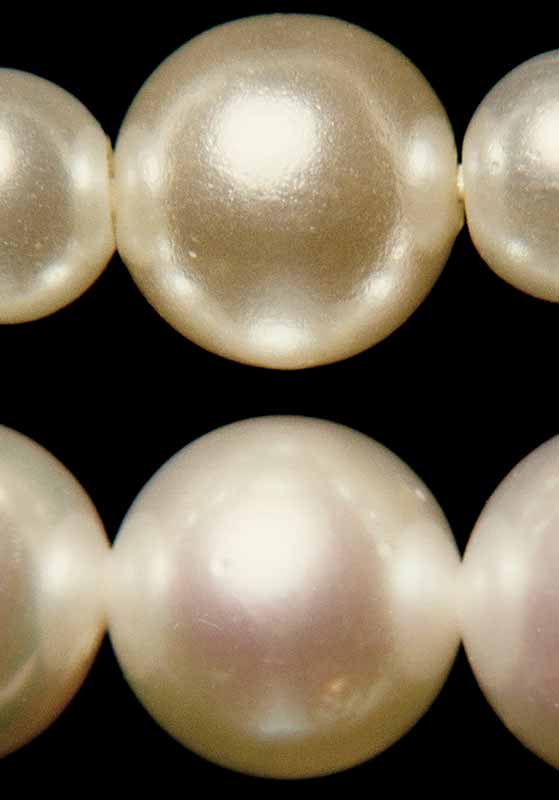 [2]
[2] [3]
[3]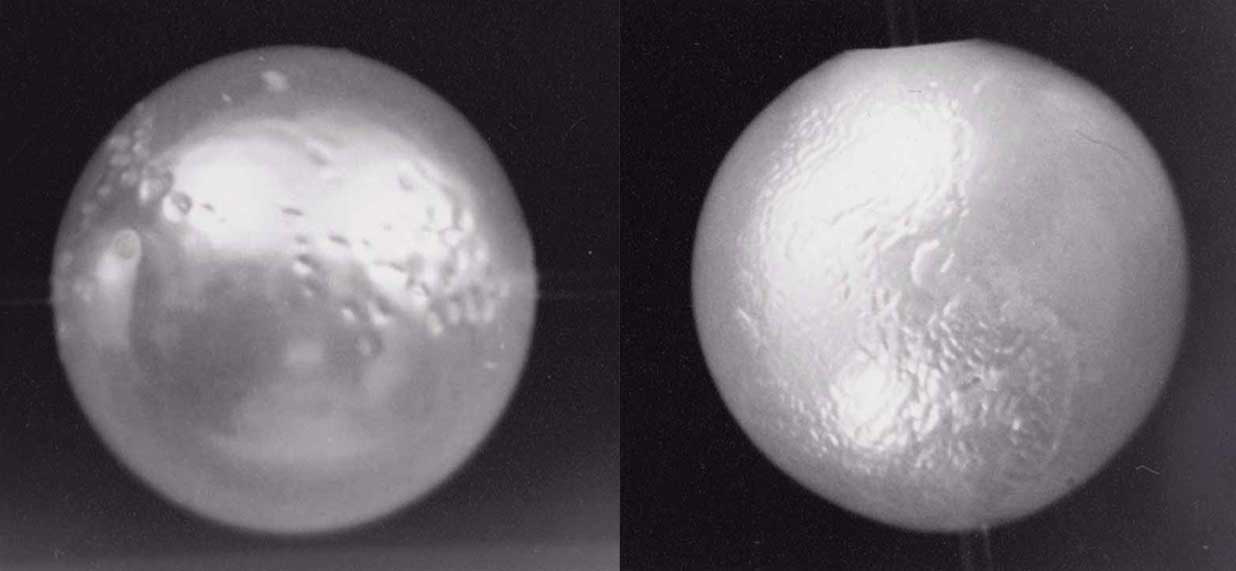 [4]
[4]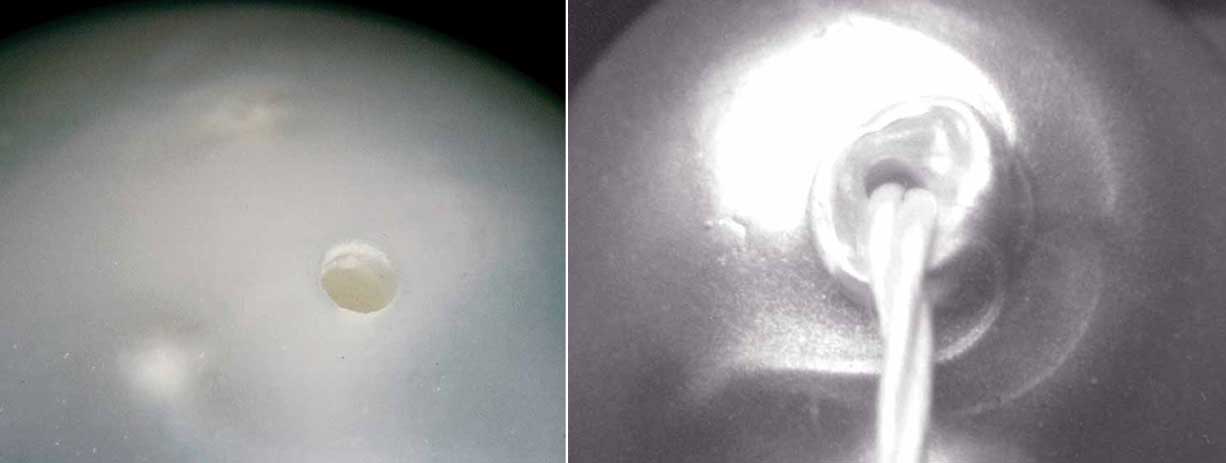 [5]
[5]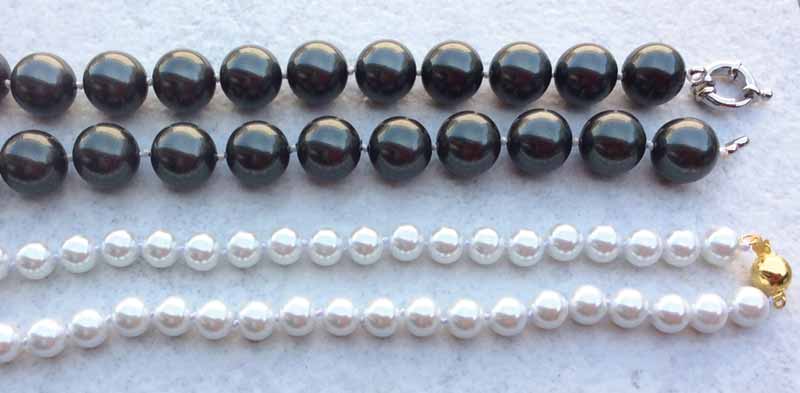 [6]
[6]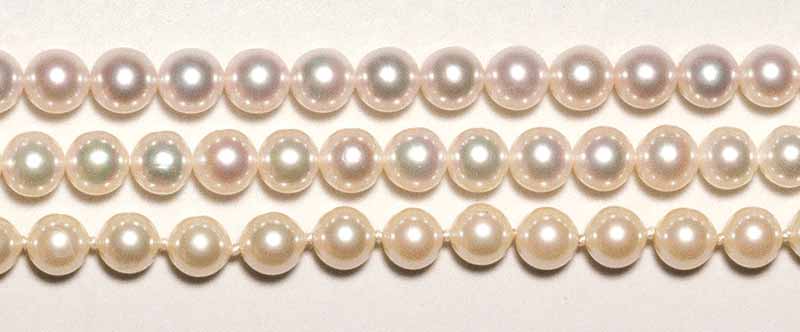 [7]
[7]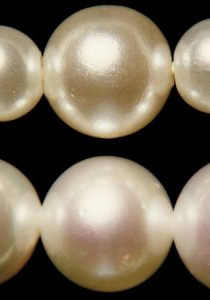


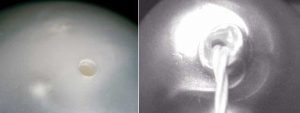
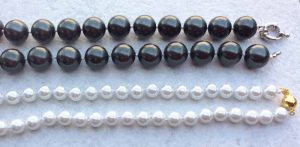
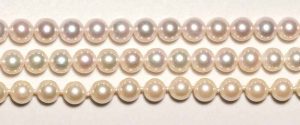
 [8]
[8] [9]
[9]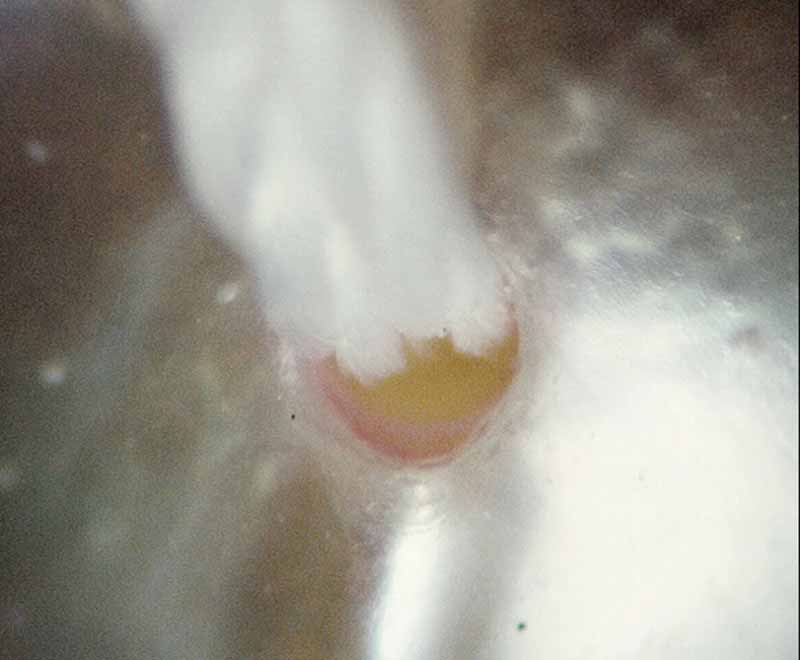 [10]
[10]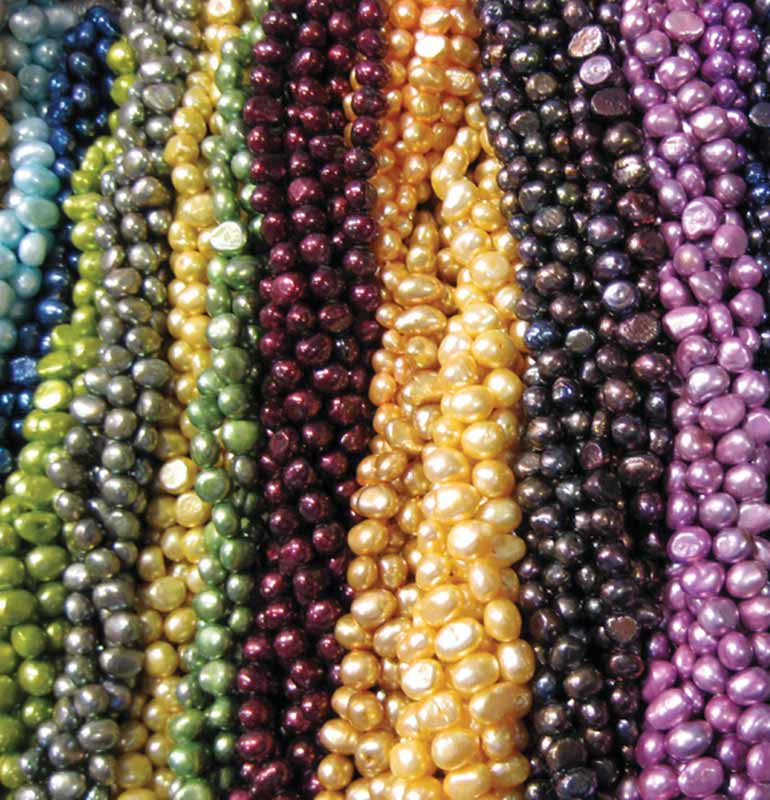 [11]
[11]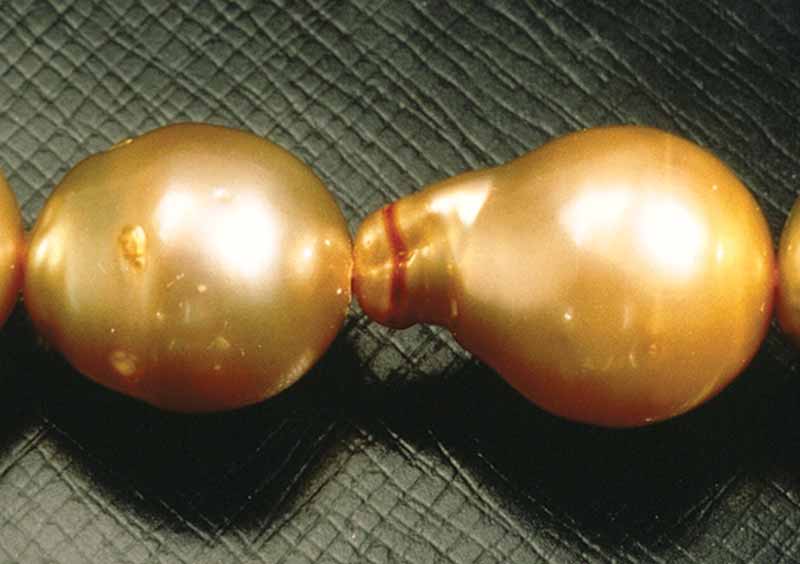 [12]
[12] [13]
[13]